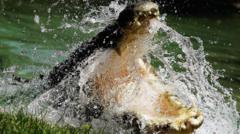In Darwin, Australia, dawn breaks over a tranquil harbor suddenly stark with urgency as government ranger Kelly Ewin carefully monitors a floating crocodile trap. With storm clouds looming, the atmosphere is charged with tension as a wild saltwater crocodile thrashes inside, awaiting capture. Home to an estimated 100,000 wild saltwater crocodiles, Australia's Northern Territory (NT) poses a unique challenge: how to manage an apex predator that was once on the verge of extinction but is now thriving.
Crocodiles were nearly hunted to extinction in the mid-20th century, with numbers dwindling to about 3,000 due to unregulated skin trade. However, since hunting was outlawed in 1971, crocodile populations have rebounded significantly. The current population growth presents a dilemma for local authorities as human-crocodile interactions become more frequent, prompting calls for management strategies that prioritize public safety.
Crocodile expert Professor Grahame Webb highlights the delicate nature of public sentiment regarding crocodiles. He warns that any negative public reaction can lead to political pressure for drastic measures that may not reflect scientific understanding of the species. "The worst thing that can happen is when people turn against crocodiles," he notes, emphasizing the balance needed to foster coexistence.
The NT's warm climate and rich waterways also create an ideal habitat for these reptiles, drawing them closer to human activities. Fatal incidents involving saltwater crocodiles are rare but do occur, such as the tragic death of a 12-year-old girl last year, which reignited discussions about crocodile population management. Under current policies, the government has recently revised its crocodile management plan, increasing the annual allowable kills from 300 to 1,200 to address rising populations while acknowledging their protected status.
Education plays a crucial role in promoting safe behaviors around crocodile habitats. The "Be Crocwise" program teaches locals and tourists about the importance of being vigilant while enjoying outdoor activities. The NT government has successfully implemented this initiative, with interest from other regions looking to replicate its successes in mitigating human-wildlife conflicts.
While tourism and exotic leather demand benefit the local economy, concerns about crocodile farming practices raise ethical questions. Traditional Aboriginal practices involving crocodiles offer a lens into sustainable management and respect for the creatures' cultural significance. Advocates argue that crocodile farming provides an economic incentive for local communities and promotes coexistence but faces opposition over the potential welfare implications for captive reptiles.
Throughout Darwin, the narratives surrounding crocodiles vary widely. Some residents advocate for stricter measures to control populations, while others emphasize the importance of coexistence and respect for native wildlife. The reality remains that human activities and crocodiles are inextricably linked in this Australian landscape.
As conservation experts warn against underestimating the inherent dangers of living near such powerful predators, the challenge of balancing safety, preservation, and socio-economic factors continues. Daily, authorities like Ewin work tirelessly to navigate the complexities of this relationship, finding solutions that aim to foster a secure environment for both wildlife and the local population.
"This is one of the few places in the world where humans have learned to coexist with a serious predator," Professor Webb observes. Finding a sustainable approach to managing crocodile populations will likely shape the future of human-crocodile coexistence in Australia’s growing urban landscapes.
Crocodiles were nearly hunted to extinction in the mid-20th century, with numbers dwindling to about 3,000 due to unregulated skin trade. However, since hunting was outlawed in 1971, crocodile populations have rebounded significantly. The current population growth presents a dilemma for local authorities as human-crocodile interactions become more frequent, prompting calls for management strategies that prioritize public safety.
Crocodile expert Professor Grahame Webb highlights the delicate nature of public sentiment regarding crocodiles. He warns that any negative public reaction can lead to political pressure for drastic measures that may not reflect scientific understanding of the species. "The worst thing that can happen is when people turn against crocodiles," he notes, emphasizing the balance needed to foster coexistence.
The NT's warm climate and rich waterways also create an ideal habitat for these reptiles, drawing them closer to human activities. Fatal incidents involving saltwater crocodiles are rare but do occur, such as the tragic death of a 12-year-old girl last year, which reignited discussions about crocodile population management. Under current policies, the government has recently revised its crocodile management plan, increasing the annual allowable kills from 300 to 1,200 to address rising populations while acknowledging their protected status.
Education plays a crucial role in promoting safe behaviors around crocodile habitats. The "Be Crocwise" program teaches locals and tourists about the importance of being vigilant while enjoying outdoor activities. The NT government has successfully implemented this initiative, with interest from other regions looking to replicate its successes in mitigating human-wildlife conflicts.
While tourism and exotic leather demand benefit the local economy, concerns about crocodile farming practices raise ethical questions. Traditional Aboriginal practices involving crocodiles offer a lens into sustainable management and respect for the creatures' cultural significance. Advocates argue that crocodile farming provides an economic incentive for local communities and promotes coexistence but faces opposition over the potential welfare implications for captive reptiles.
Throughout Darwin, the narratives surrounding crocodiles vary widely. Some residents advocate for stricter measures to control populations, while others emphasize the importance of coexistence and respect for native wildlife. The reality remains that human activities and crocodiles are inextricably linked in this Australian landscape.
As conservation experts warn against underestimating the inherent dangers of living near such powerful predators, the challenge of balancing safety, preservation, and socio-economic factors continues. Daily, authorities like Ewin work tirelessly to navigate the complexities of this relationship, finding solutions that aim to foster a secure environment for both wildlife and the local population.
"This is one of the few places in the world where humans have learned to coexist with a serious predator," Professor Webb observes. Finding a sustainable approach to managing crocodile populations will likely shape the future of human-crocodile coexistence in Australia’s growing urban landscapes.




















